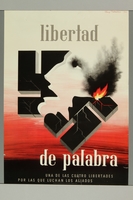Overview
- Brief Narrative
- Cuatro Libertades (Four Freedoms) is an American propaganda poster produced during World War II for distribution in Central America. It is part of a series of five posters created to promote President Roosevelt’s Four Freedoms. In his January 1941 State of the Union address, FDR proposed four fundamental freedoms that people everywhere in the world should enjoy: Freedom of Speech, Freedom of Worship, Freedom from Want, and Freedom from Fear. The Spanish language posters were published by the Office of Inter-American Affairs in 1942 to gain support for the Allies in Central America. Herbert Bayer, Alexey Brodovitch, Edward McKnight Kauffer, and John Atherton were commissioned to design the posters by Nelson Rockefeller, Coordinator of Inter-American Affairs. This colorful typographic poster was designed by Herbert Bayer. Bayer was a Bauhaus trained graphic designer who fled Germany for the US after his works were displayed in the 1937 Nazi exhibition, Degenerate Art.
- Artwork Title
- Cuatro Libertades
- Alternate Title
- Four Freedoms
- Series Title
- Cuatro Libertades
- Date
-
publication/distribution:
1942
- Geography
-
issue:
Washington (D.C.)
- Credit Line
- United States Holocaust Memorial Museum Collection, Gift of Carlos Zepeda
- Markings
- front, top, red ink : LIBERTAD DE CULTOS [Freedom of Religion]
front, center, green ink : LIBERTAD DE PALABRA [Freedom of Speech]
front, center, blue ink : LIBRES [Free]
front, center, red ink : LIBRES DE MISERIA [Freedom from Want]
front, bottom, green ink : LIBRES DE TEMOR [Freedom from Fear]
front, bottom, small font, black ink : Publicado por El Coordinador de Asuntos Interamericanos, Washington, E.U.A. [Published by the Coordinator of Inter-American Affairs, Washington, U.S.A]
front, lower left corner, imprinted, blue ink : herbert bayer - Contributor
-
Designer:
Herbert Bayer
Publisher: Office of the Coordinator of Inter-American Affairs
- Biography
-
Herbert Bayer was born on April 5, 1900, in Haag, Austria, near Vienna. Bayer studied at the Bauhaus school in Weimar under Johannes Itten and Wassily Kandinsky. In 1925, Bayer was hired by Walter Gropius as an instructor at the school upon its move to Dessau, where he headed the graphic design and typography workshop. In 1928, Bayer moved to Berlin to run his own design studio. He also did advertising work and served as art director of Paris Vogue from 1929-1930. In 1933, Hitler was appointed Chancellor of Germany and, by that summer, had established the Nazi dictatorship. The regime viewed the Bauhaus as a center of communist activity and the school, then under the leadership of Mies van der Rohe, was shut down in 1933 under pressure from the government. Many of Bayer's Bauhaus colleagues, including Gropius, fled the country. Bayer remained in Berlin and his work included pro-Hitler tourist brochures for the 1936 Olympics. He left Germany for the United States in 1938 after his work was included in the Nazi propaganda exhibition, Degenerate Art. He became one of the most influential graphic artists of the 20th century. He married Joella Haweis and became a US citizen in 1944. Bayer, age 85, died in September 1985.
Physical Details
- Language
- Spanish
- Classification
-
Posters
- Category
-
War propaganda
- Object Type
-
Posters, American (lcsh)
- Physical Description
- Rectangular offset lithograph poster on offwhite paper with a background design of blue swirling brushstrokes. It features 5 phrases printed in bold stylized font, organized around the word, Libres, which is tilted across the center of the poster, in the largest font, blue with black shading; the font size decreases from left to right. Surrounding it are 4 phrases, whose font size increases from right to left, all tilted at different angles, from the top: Libertad de Cultos, red ink shaded with yellow and blue; Libertad de Palabra, green ink shaded with yellow, red, and blue; Libres de Miseria, red shaded with black; Libres de Temor, green shaded with yellow.
- Dimensions
- overall: Height: 20.000 inches (50.8 cm) | Width: 14.250 inches (36.195 cm)
- Materials
- overall : paper, ink
- Inscription
- .
Rights & Restrictions
- Conditions on Access
- No restrictions on access
- Conditions on Use
- No restrictions on use
Keywords & Subjects
Administrative Notes
- Legal Status
- Permanent Collection
- Provenance
- The poster was donated to the United States Holocaust Memorial Museum in 2012 by Carlos Zepeda.
- Record last modified:
- 2022-08-02 15:36:05
- This page:
- https://collections.ushmm.org/search/catalog/irn47924
Download & Licensing
In-Person Research
- By Appointment
- Request 21 Days in Advance of Visit
- Plan a Research Visit
- Request to See This Object
Contact Us
Also in Carlos Zepeda collection
The collection consists of two posters relating to the propaganda efforts of the United States government in Central America during World War II.
Date: 1942

US propaganda poster with a swastika shattered by a symbolic face promoting freedom of speech in Central America
Object
Libertad de Palabra (Freedom of Speech) is an American propaganda poster produced during World War II for distribution in Central America. Designed by Alexey Brodovitch, this poster features a big black swastika broken into jagged pieces by a symbolic image of Free Speech, a face with an open mouth. It is part of a series of five posters created to promote President Roosevelt’s Four Freedoms. In his January 1941 State of the Union address, FDR proposed four fundamental freedoms that people everywhere in the world should enjoy: Freedom of Speech, Freedom of Worship, Freedom from Want, and Freedom from Fear. The Spanish language posters were published by the Office of Inter-American Affairs in 1942 to gain support for the Allies in Central America. Herbert Bayer, Alexey Brodovitch, Edward McKnight Kauffer, and John Atherton were commissioned to design the posters by Nelson Rockefeller, Coordinator of Inter-American Affairs. Brodovitch had fled Bolshevik rule in Russia for Paris in 1920, then immigrated to the United States in 1930, eventually working as art director of Harper’s Bazaar for nearly 25 years.



